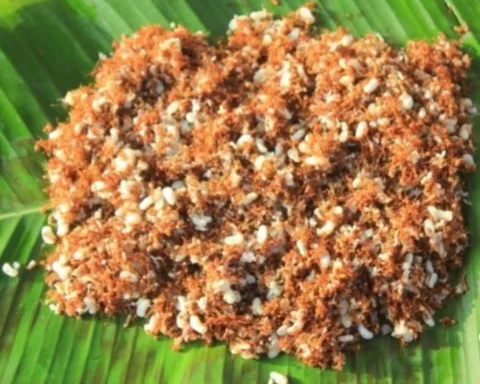Get ready to embark on a culinary adventure as we dive into the whimsical world of preparing Kassoli! Imagine a kitchen filled with the delightful aroma of spices and the promise of a delectable dish that's as enchanting to make as it is to eat. Roasted maize or Kassoli is a popular snack in Uganda. The fresh maize is roasted over a medium fire to get all the sides brownish. It has a sweet and smoky taste. It is a seasonal, delicious snack not available all year round.
With a dash of tradition and a sprinkle of creativity, crafting Kassoli is like composing a symphony of flavours that will leave your taste buds dancing. So, roll up your sleeves, don your apron, and unlock the secrets to whipping up this magical culinary masterpiece!
Table of Contents
Origin of Kassoli
Kassoli originated as a staple food in various regions of Uganda, where maize has been a significant agricultural crop for centuries. The dish is particularly popular among the Baganda ethnic group and other communities in Uganda.
Culinary History of Kassoli
A blend of indigenous traditions and external interactions has influenced Ugandan culinary history. The introduction of ingredients and cooking techniques through trade, colonization, and cultural exchanges has enriched Uganda's cuisine with diverse flavours and practices.
- Maize as a Staple Crop: Maize (corn) has been a staple crop in Uganda for centuries. It was introduced to the region through trade and colonial interactions. The versatility of maize made it an essential food source, and it became a staple in the diet of many Ugandans.
- Indigenous and Colonial Influences: The culinary practices of Uganda have been influenced by indigenous cultures and external factors such as colonization. Indigenous communities developed ways of preparing and consuming maize, which could have included methods similar to nixtamalization, where maize is soaked in an alkaline solution to improve its nutritional value.
- Cultural and Regional Variations: Ugandan cuisine is diverse and varies by region and ethnic group. Different communities might have developed unique ways of preparing maize-based dishes, including Kassoli. Traditional dishes often hold cultural significance and are passed down through generations.
- Rural and Urban Dynamics: The preparation of dishes like Kassoli might have been more prevalent in rural areas where maize is commonly grown and processed. However, the dish's popularity could extend to urban areas and gatherings, especially for cultural celebrations and events.
- Nutritional Importance: Maize-based dishes like Kassoli were culturally significant and provided essential nutrients and energy. These dishes were often a source of sustenance in communities where access to diverse foods was limited.
- Evolution Over Time: Culinary traditions are not static; they evolve based on technological advancements, changing agricultural practices, and external influences. As Ugandan society changed, so did its culinary techniques.
Quick Guide to Cook Kassoli
Here's a basic step-by-step recipe for making Kassoli, a Ugandan dish made from maize. Remember that variations of this recipe may exist, and personal preferences can lead to adjustments in ingredients and quantities.
Ingredients:
- 2 cups maize kernels (dried and treated)
- Water
- Salt (to taste)
Start by preparing the maize kernels. These kernels should be dried and treated through a process called nixtamalization. To do this, boil water in a large pot and add the dried maize kernels. Add wood ash or calcium hydroxide (lime) to the boiling water. This helps in softening the kernels and improving their nutritional value.
Allow the maize to simmer for about 20-30 minutes until the kernels become soft and partially cooked. The water may turn slightly murky due to the nixtamalization process. Drain the maize and rinse it thoroughly to remove residual ash or lime. Grinding the Maize: After rinsing, drain the maize kernels well. Use a grain mill or a food processor to grind the maize into a coarse texture. The ground maize is often called "posho" or "githeri."
In a large pot, bring water to a boil. The amount of water will depend on how thick you want the Kassoli to be; you can start with around 6-8 cups of water. Slowly add the ground maize while stirring continuously to avoid lumps from forming. This helps create a smooth consistency.
Lower the heat to a simmer and continue stirring frequently to prevent sticking to the bottom of the pot. Allow the mixture to cook for about 20-30 minutes until it thickens and the maize is fully cooked. The Kassoli should have a porridge-like consistency.
Add salt to taste, stirring well to distribute the seasoning evenly. You can serve Kassoli hot as a comforting and filling dish. Kassoli is often accompanied by groundnut (peanut) sauce, vegetables, beans, or meat stews.
Variations in Kassoli
This Ugandan dish, made from maize, can differ based on regional preferences, available ingredients, and individual creativity. While the core ingredients remain maize and water, here are some common variations and additions you might find in different recipes:
- Vegetables: Some variations of Kassoli include the addition of vegetables such as chopped spinach, pumpkin leaves (locally known as "dodo"), or amaranth leaves ("nakati"). These vegetables add nutritional value and colour to the dish.
- Beans: To enhance the protein content and texture, cooked beans like cowpeas, kidney beans, or black-eyed peas can be mixed into the Kassoli. This combination is often referred to as "Karo and beans."
- Groundnut Sauce: One of the popular accompaniments to Kassoli is groundnut (peanut) sauce. The nutty, savoury sauce adds flavour and richness to the dish.
- Spices: Various spices can be added to Kassoli to enhance its flavour. Common spices include black pepper, cumin, coriander, and turmeric.
- Meat: In some variations, cooked meat, such as beef, chicken, or goat, can be added to the Kassoli to make it heartier and more substantial.
- Milk or Coconut Milk: For a creamier and richer version of Kassoli, some recipes include milk or coconut milk during the cooking process. This can alter the flavour and texture of the dish.
- Fermentation: In certain regions, Kassoli can undergo a natural fermentation process, which results in a slightly tangy flavour and changes the consistency of the dish.
- Sweet Kassoli: While the traditional version of Kassoli is savoury, some variations incorporate sweet elements such as sugar, honey, or coconut sugar. These sweet versions might be enjoyed as a dessert or breakfast dish.
- Herbs and Greens: Fresh herbs like cilantro or parsley can be added as garnishes, giving the dish a burst of freshness. Additionally, chopped scallions or green onions can be stirred for extra flavour.
- Nuts and Seeds: Chopped nuts, seeds (like sunflower seeds or sesame seeds), or dried fruits can be sprinkled on top for added crunch and texture.
- Chillies or Peppers: For those who enjoy a spicy kick, chopped chillies or ground red pepper can be added to the Kassoli for heat.
Conclusion
Kassoli, the maize marvel of Uganda, proves that simplicity can be downright delicious. From its humble beginnings as corn kernels transformed by tradition, Kassoli's variations dance with vegetables, beans, and even the irresistible nutty embrace of groundnut sauce. So, whether enjoyed as a hearty comfort or a flavourful canvas for culinary creativity, Kassoli brings the spirit of Ugandan cuisine to the heart and palate with a wink and a full belly.
FAQs
What is the national dish of Uganda?
The national dish of Uganda is "Posho and Sauce," also known as "Ugali and Sauce." It consists of a starchy staple made from maize flour (posho/ugali) served alongside a variety of sauces, including meat, beans, vegetables, or groundnut (peanut) sauce.
Is Ugandan food spicy?
Ugandan food is generally not known for being overly spicy. While some dishes may incorporate mild spices or chillies for flavour, the overall level of spiciness is typically moderate compared to some other cuisines in the region.
What is the breakfast of Uganda?
A common breakfast in Uganda often includes dishes like "Rolex," a rolled chapati (flatbread) filled with eggs, vegetables, and sometimes meat. Additionally, local fruits, porridges made from grains like millet or maize, and tea or coffee are popular morning options.
What other dishes are made with maize other than Kassoli?
In addition to Kassoli, another popular maize-based dish in Africa is "Sadza" or "Pap," a staple in countries like Zimbabwe and South Africa. Sadza is a cooked maize meal porridge that serves as a base for various stews, sauces, or vegetables and is a fundamental part of many African diets.










